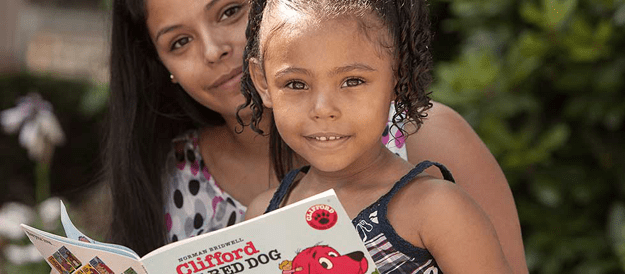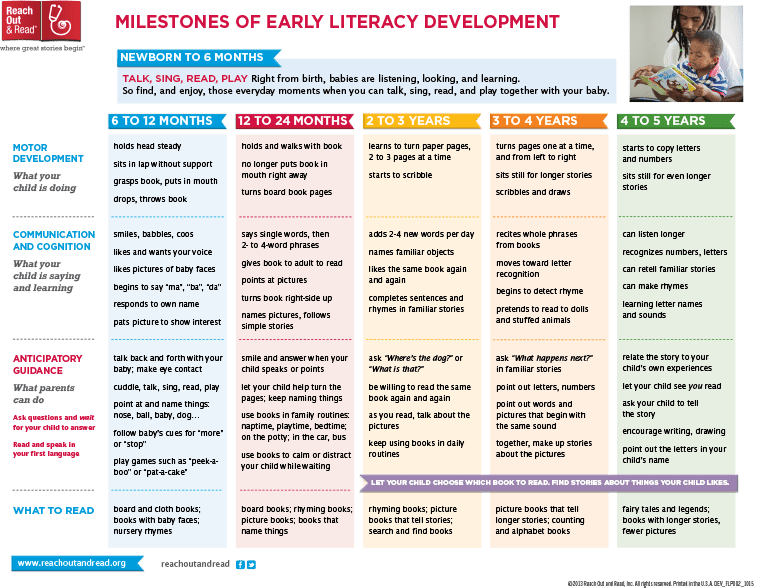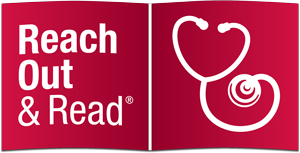PARENT RESOURCES

Books build better brains! Reach Out and Read encourages all parents
to make reading with their children part of their daily routine.
Tips for Selecting the Best Books for Your Kids
These guidelines detail the kinds of books that are most suitable for children of different age groups. You can also download Reach Out and Read’s Annotated Book List for Children for a list of doctor-recommended books for children of all ages.
- Board books with photos of babies
- Brightly-colored board books to touch and taste
- Books with pictures of familiar objects like balls and bottles
- Small books sized for small hands
- Sturdy board books they can handle and carry
- Books with photos and pictures of children doing familiar things such as sleeping, eating, and playing
- Goodnight books for bedtime
- Books about saying goodbye and hello
- Books with only a few words on the page
- Books with simple rhymes or predictable text
- Books with board pages and books with paper pages
- Books that are silly and funny
- Books with rhymes, rhythms, and repetitions they can learn by heart
- Books about children and families
- Books about making friends
- Books about food
- Books about animals
- Books about trucks
- Word books
General Tips
- Make reading part of every day, even for just a few minutes.
- Have fun.
- Talk about the pictures. You do not have to read the book to tell a story.
- Let your child turn the pages.
- Show your child the cover page. Explain what the story is about.
- Run your finger along the words as you read them.
- Silly sounds, especially animal sounds, are fun to make.
- Choose books about events in your child’s life such as starting preschool, going to the dentist, getting a new pet, or moving to a new home.
- Make the story come alive. Create voices for the story characters.
- Ask questions about the story. What do you think will happen next? What is this?
- Let your child ask questions about the story. Talk about familiar activities and objects.
- Let your child retell the story.
- Visit your local library often.
Hold your baby on your lap while you read.
Babies like…
- board books;
- pictures of babies;
- rhymes and songs from the same book over and over;
- and when you point at pictures – this is how babies learn!
Let your toddler move around while you are reading.
Name the pictures – this is how toddlers learn new words.
Read labels and signs wherever you go.
Toddlers like …
- the same book over and over;
- a book at bedtime;
- to choose and hold the book;
- books about food, trucks, animals, and children;
- and books with a few words.
Read labels and signs wherever you go.
Keep different books around the house and let your child choose.
Two-year-olds like …
- to help turn the pages;
- to fill in the words in a story they know;
- to point and name pictures;
- to hear the same book over and over;
- books that are silly;
- and animal books and animal noises.
Have your child sit close or on your lap while reading.
Ask questions about the story.
Let your child tell you stories.
Make weekly visits to the children’s room at the library so your child can choose more books.
Children like …
- longer books that tell stories;
- books without words;
- alphabet and counting books;
- books about families, friends, and going to school;
- and a book at bedtime.
Reach Out and Read’s well-known chart, MILESTONES OF EARLY LITERACY DEVELOPMENT, offers information – in an easy-to-read grid – on the developmental stages (both motor and cognitive) that lay the foundation for learning to read. Targeted to ages 6 months through 5 years, the MILESTONES include tips and guidance for healthcare providers, parents, and caregivers on choosing books and reading aloud to children at different ages.


